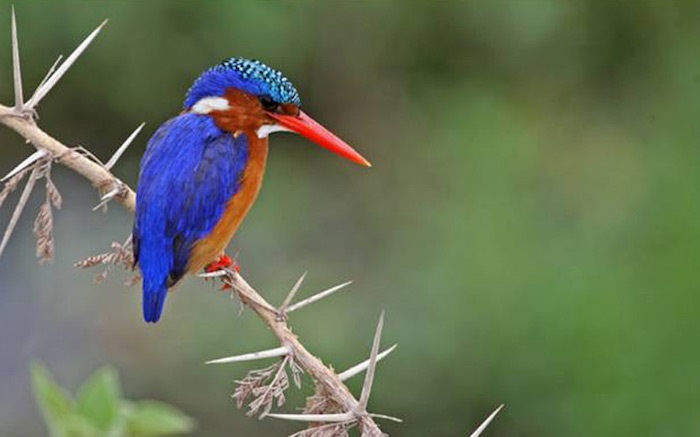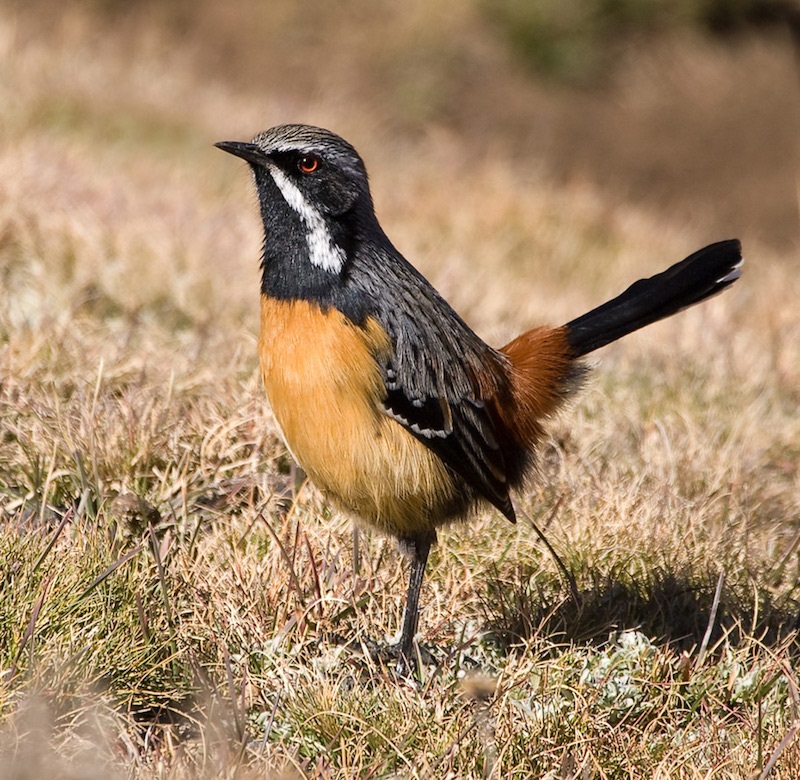Roughly defined, the Eastern Cape is the part of South Africa which lies east of the 30 degree east line of longitude and south of the 30 degree 30 minute line of latitude.
A coastline, rocky in parts but with many sandy beaches, arid semi-desert scrub, grasslands, forests and large tracts of cultivated lands in some areas gives the Eastern Cape a wide mosaic of habitats. In consequence, the bird list for the province is well in excess of 450!
The climate is mild with temperatures seldom below freezing and, except for the interior, seldom rising above 35 degrees Celsius. The southern coast and its immediate interior forms part of the winter rainfall region of South Africa; the rest of the region receiving its rain mainly in summer.

The main towns in the region are Port Elizabeth and East London, both coastal, and Graaff-Reinet, Cradock and Queenstown in the interior. Roads between these and other larger towns are tarred. Most of the minor roads are gravel surfaced.
Some top birding sites include:
Cape Recife Nature Reserve, Port Elizabeth (Map)
This reserve is situated on the outskirts of Port Elizabeth and is one of the best seabird sites in the province. There is a large tern roost which, in summer, can boast Common, Swift (Great Crested); Caspian, Sandwich and Roseate Terns and Kelp Gulls. The rare Damara Tern, endemic to Southern Africa, is often present and Antarctic Tern visit in good numbers June to August. White-fronted Plovers, Ruddy Turnstones and Whimbrels all feed along the water’s edge. African (Jackass) Penguin can sometimes be seen just off-shore and, when a strong south-easterly wind is blowing, albatrosses and petrels can be seen from the shore. The rocks just metres off-shore often hold large numbers of Cape Cormorant, White-breasted Cormorant.

Malachite Kingfisher Corythornis cristatus ©Mike Bayman Birding Ecotours
Included in the reserve is one of the city’s sewerage disposal works and a hide has been built at one of the settling ponds. Kelp and Grey-headed Gulls can be well seen from the hide, along with Pied and Malachite Kingfishers, Cape Wagtails, Purple Gallinules, Yellow-billed Ducks and an occasional African Marsh Harrier.
Mondplaas Ponds – Gamtoos River Mouth (Map)
Situated some 60 kilometres west of Port Elizabeth, the ponds are a short distance inland from the Gamtoos River mouth. A good place for waterfowl with four or five species of duck usually present. Other water birds include Darter, two cormorant species, Purple and Grey Herons, Purple Gallinule (Swamphen); Black Crake, African Rail and the occasional African Jacana. The river mouth, approximately 10 kilometres away by road, has a large mudbank which holds many migrant waders in summer. Red Knot, Terek Sandpiper, Bar-tailed Godwit, Eurasian Curlew and African Black Oystercatcher are among the species to be seen. The adjacent dunes are a good site for Eurasian Hobby in the summer.
These two sites have, from time to time, produced some most unexpected birds such as the Citrine Wagtail (the third record for Africa as a whole) and Garganey. The farm lands and bush along the road between these spots is good birding country and species such as Bokmakierie, Southern Boubou (Shrike), Southern Tchagra, Bar-throated Apalis, Stanley’s Bustard, Glossy Starling and Pied Starling might be seen.
Mountain Zebra National Park (Map)
This National Park was proclaimed primarily to protect the few remaining Cape Mountain Zebra (Equus zebra). It is situated about 15 kilometres south-west of Cradock in what is known locally as the Karoo, a semi-arid area of grass and scrub with cold winters and hot summers. This is a good place to get to grips with the larks and chats of the dry areas. Long-billed, Large-billed, Spike-heeled, Red-capped and Eastern Clapper Larks are particularly obvious in the spring (August to November) when breeding is in full swing. Familiar and Sickle-winged Chats are plentiful. Other dry country birds include Cape Penduline Tit, Acacia Pied Barbet, Cardinal Woodpecker, Fairy Flycatcher, Red-winged Starling and a host of others can be seen. The list for the park is over 200 species, a good proportion of them being resident. Other interesting birds include Layard’s Tit-babbler, Dusky Sunbird, Pale-winged Starling, Namaqua and Rufous-eared Warblers and Cape Rock Thrush.

Naudesnek Pass, peaking at 2 740 metres, is the highest mountain pass in South Africa. This area, together with the adjacent areas of Lesotho, gives some of the best opportunities to see Orange-breasted Rockjumper, Drakensberg Siskin, Lammergeier and Mountain Pipit; three species with highly restricted ranges. Other species of interest are Barratt’s Warbler, Black (Verreaux’s) Eagle, Cape Vulture, Greywing Francolin and Rock Pipit. Ground Woodpeckers are common. Yellow-breasted Pipits occur on the eastern side of the pass but are not at all common. The villages of Rhodes on the west and Maclear on the east provide both accommodation and easy access to the pass itself.
Text Source: Fatbirder
Map Source: Googlemaps™
Photo Source: © Birding Ecotours
